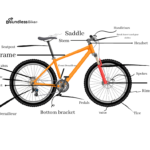If you’re a bike enthusiast, you may have wondered whether all bike chains are one-size-fits-all. Maybe you broke your chain and need to replace it or want to upgrade its quality without thinking twice about compatibility issues. Fear not! In this post, we’ll explore the question of whether bike chains are universal and provide some useful information that can help prevent any headaches along the way. So buckle up (or rather, helmet on), because we’re about to dive into the world of bicycle chains!
Are bike chains universal?
No, bike chains are not universal. Different types of bikes may require different types of chains based on factors such as the number of gears, the width of the cassette, and the type of drivetrain.
For example, road bikes typically have narrower chains than mountain bikes, and bikes with more gears will require a chain with more links than bikes with fewer gears. Additionally, some bike chains are designed to work with specific types of drivetrains, such as Shimano, SRAM, or Campagnolo.
It’s important to select the correct chain for your bike to ensure optimal performance and avoid damage to your bike’s drivetrain. Always consult your bike’s manufacturer or a bike mechanic to ensure you select the correct chain for your bike.
How do bike chains work?
Bike chains work by transferring power from the pedals to the rear wheel, which propels the bike forward. The chain consists of a series of interlocking metal links that are designed to mesh with the gear teeth on the front and rear sprockets.
When you pedal the bike, the chain is pulled along the teeth of the front chainring, which rotates the rear wheel through the cassette. As the chain moves from one sprocket to another, it transfers the force generated by your pedaling to the rear wheel.
The key to a smooth and efficient ride is ensuring that the chain is properly lubricated and tensioned. Over time, chains can stretch and become worn, which can cause them to slip or even break. Regular maintenance, such as cleaning and lubricating the chain, can help prolong its lifespan and ensure a smoother ride.
Different Types of Bikes Chains

- Single-speed chains: Single-speed chains are designed for bikes with only one gear. They are typically wider and thicker than chains designed for multi-speed bikes and are often more durable. Single-speed chains come in various lengths to accommodate different bike sizes.
- Multi-speed chains: Multi-speed chains are designed for bikes with multiple gears. They are typically narrower and thinner than single-speed chains to fit between the smaller cogs of the cassette. Multi-speed chains come in various lengths and are compatible with different numbers of gears, such as 6, 7, 8, 9, 10, 11, or 12-speed.
- Road bike chains: Road bike chains are designed for use on road bikes with drop handlebars. They are typically narrower and lighter than mountain bike chains and are designed to work with road bike-specific drivetrains, such as Shimano or Campagnolo. Road bike chains often come in various lengths and are compatible with different numbers of gears.
- Mountain bike chains: Mountain bike chains are designed for use on mountain bikes and other off-road bikes. They are typically wider and more durable than road bike chains and are designed to work with mountain bike-specific drivetrains, such as SRAM or Shimano. Mountain bike chains often come in various lengths and are compatible with different numbers of gears.
- E-bike chains: E-bike chains are designed for use on electric bikes, which may have higher torque and power requirements than traditional bikes. E-bike chains are typically stronger and more durable than standard bike chains and may be designed to work with e-bike-specific drivetrains.
How to choose the right bike chain?
If you’re looking to buy a new bike chain, there are a few things you’ll need to take into consideration in order to choose the right one. First, you’ll need to know the width of your bike’s chainstay. This measurement will determine the width of the chain you need. Next, you’ll need to know the number of speed settings on your bike. This will determine the number of cogs on the chain. Lastly, you’ll need to consider the compatibility of the chain with your bike’s drivetrain. Some chains are only compatible with certain drivetrains. Now that you know what to look for, here are a few tips on how to choose the right bike chain:
- If you’re unsure of the width of your bike’s chainstay, measure it with a ruler or tape measure. The measurement should be taken from the center of the bottom bracket to the center of the rear axle.
- The number of speed settings on your bike will determine the number of cogs on the chain. For example, if you have a 10-speed bike, you’ll need a 10-speed chain.
- Compatibility is important when choosing a bike chain. Some chains are only compatible with certain drivetrains. Make sure to check compatibility before making your purchase.
Faq
You should replace your bike chain when it becomes worn or stretched beyond its recommended length, which can lead to reduced shifting performance and increased wear on your bike’s cassette and chainrings. A general rule of thumb is to replace your chain every 1,000 to 2,000 miles, depending on your riding style and conditions.
You can check the wear on your bike chain by measuring its length with a chain wear tool or ruler. If the chain has stretched beyond its recommended length, it’s time to replace it. You may also notice increased noise, skipping or slipping of gears, or reduced shifting performance, which can indicate a worn chain.
You should choose a chain that is the correct length for your bike, which can vary depending on the number of gears and the size of your bike’s cassette and chainrings. Consult your bike’s owner’s manual or a bike mechanic to determine the correct chain length for your bike.
No, you should always use the type of chain recommended by the manufacturer for your bike’s drivetrain. Using the wrong type of chain can lead to reduced shifting performance, increased wear and tear on your bike’s components, and potential safety issues.
Conclusion
In conclusion, bike chains are generally not universal. It’s important to make sure your chain is compatible with your bike before making a purchase so you don’t end up wasting money on the wrong product. This article has hopefully given you a better understanding of how different types of bike chains work and what to look out for when shopping for one. Whatever type of chain you choose, it’s important that you take good care of it by cleaning and lubing regularly in order to keep it running smoothly.






